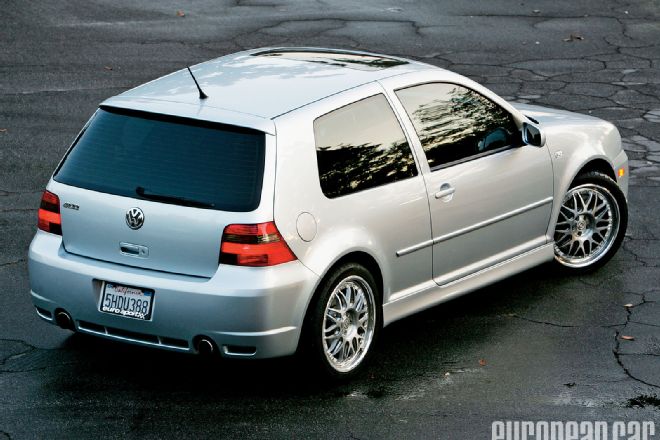When the Volkswagen R32 was released to the U.S. in late 2003, reviews were mixed. among the biggest complaints were the price and the lack of kick-you-in-the-back-of-the-head power. All the reviews did share one common "but": The R32 is an extremely balanced vehicle with a lot of potential. Personally, I think the VR6 engine makes sounds that can give you an ear-to-ear smile, but I agree that it needs more oomph in the horsepower department. While it's possible to add a few simple bolt-on modifications to squeeze few extra ponies from the 3.2-liter, to actually make the R32 a force to be reckoned with it needs at least 100 or more horses. We contacted VF Engineering in our search for a forced-induction system that could help us transform an ordinary MkIV R32 into something extraordinary.
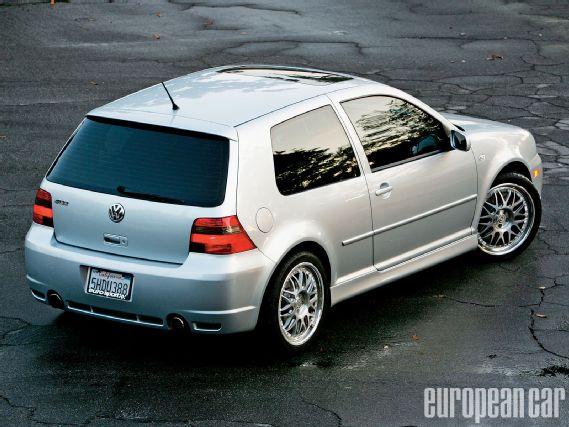 |
Volkswagen MkIV R32 - Proven
|
Volkswagen MkIV R32 - Proven
Vehicle Data
Engine: 3.2-liter V6, dohc, 24-valve
Transmission: Six-speed manual
Mileage: 36,873
Current modifications: None
Dyno data: Dynojet 224 2WD
Temperature: 69-72° F
Test octane: 91
Test gear: Fourth
Baseline
Peak power: 199 hp @ 6,400
Peak torque: 199 hp @ 6,400
Temperature: 78° F
Humidity: 29%
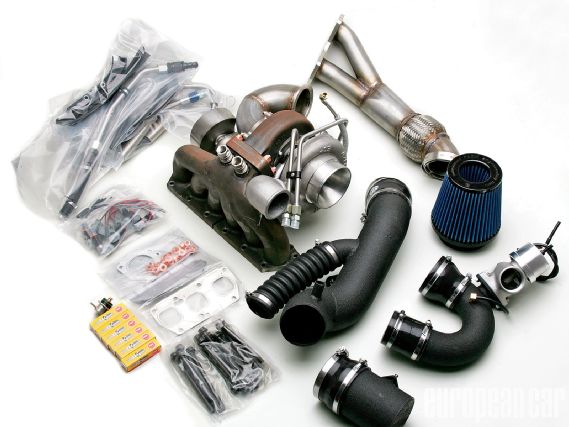 |
Volkswagen MkIV R32 - Proven
|
Volkswagen MkIV R32 - Proven
Test Notes
The baseline and all subsequent tests took several days to complete because of the time it takes to install the VF-Engineering RSS-32 turbocharger system. Testing was done with the same tank of 91 octane fuel for the baseline, VFE RSS-32, and Milltek dyno runs. The horsepower and torque figures were measured at the front wheels and were gathered by putting the all-wheel drive R32 into 2WD mode by unplugged the factory Haldex unit. Keep in mind that there are many variables that can affect dyno numbers; what's important is to look at differences between each run. These differences are what verify the validity of the manufacturer's power and torque claims.
VF Engineering
RSS-32
stage 1 (10-11 psi)
Test 1
Performance
Peak power: 326 hp @ 6100 rpm
Peak torque: 315 lb-ft @ 4700 rpm
Max power gain: 131 hp @ 6100 rpm
Max torque gain: 130 lb-ft @ 4700 rpm
*Rev limiter increased to 6600 rpm
Temperature: 80° F
Humidity: 30%
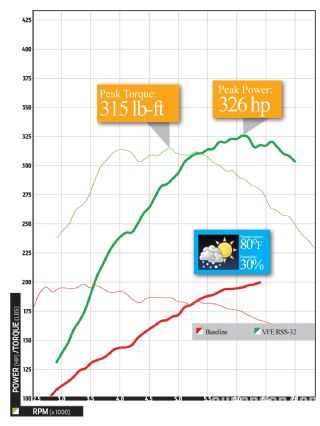 |
Graph 1: Baseline vs. VFE RSS-32
|
Graph 1: Baseline vs. VFE RSS-32
Parts: GT35R Garrett turbo, GReddy Type-R bypass valve, EV14 550cc injectors, GIAC software, downpipe, 02 sensor heat sinks, water and oil lines, Tial 44mm wastegate w/VFE shield and hard line, MAF housing, air filter, intake and discharge pluming, silicon couplers, support bracket, V band clamps, spark plugs, head spacer w/hardware, hose clamps, oil supply banjo
Tools: A lot; professional installation recommended
Installation time: Depending on skill level, approximately 2-3 days
MSRP: $7,950
Pros
• Cast alloy exhaust manifold featuring a divided turbine inlet design to ensure the exhaust gases from each cylinder merge at the right time optimizing flow; design also ensures that each oxygen sensor is accurately monitoring the correct cylinder bank (a must for OEM emission regulation)
• Massive 47mm GReddy Type R valve keeps boost under control and the engine control unit happy
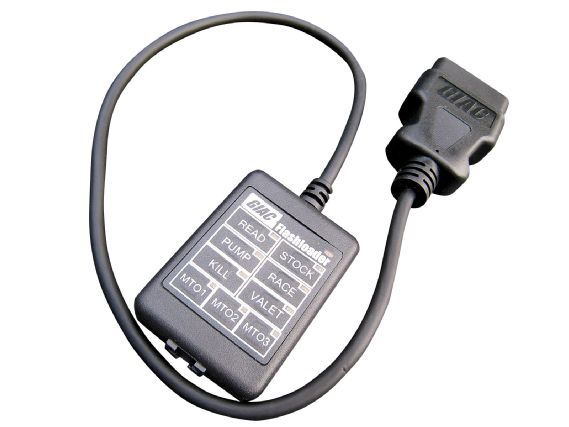 |
Volkswagen MkIV R32 - Proven
|
Volkswagen MkIV R32 - Proven
• Larger MAF sensor housing featuring a stainless steel honeycomb air flow straightener designed to reduce the turbulence of the air as it crosses the sensor to ensure a more accurate airflow reading
• Tial 44mm wastegate with VFE heat shield minimizes the potential of boost creep under full throttle
• V-band clamps to make downpipe removal quick and easy
• EV14 550cc injectors feature a dual split and angled spray pattern just like the factory units
• Stainless steel water, oil return, and wastegate signal hard lines to ensure maximum reliability from increased thermal activity; also allow for maximum clearance
• Manifold design allowing the factory double-walled stainless steel heat shield to be reinstalled with slight modification
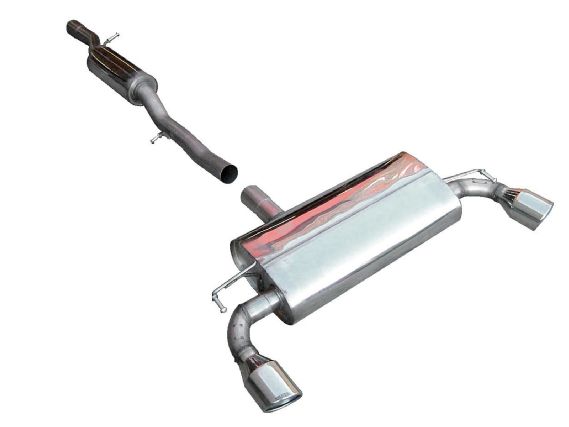 |
Volkswagen MkIV R32 - Proven
|
Volkswagen MkIV R32 - Proven
• Support bracket to hold the weight of manifold/turbo assembly and help constrict movement during thermal expansion reducing the risk of breakage or loosening hardware
• Downpipe bolts can be used with the factory catalytic converter and exhaust system
• Hot coolant from the turbocharger is not fed into the overflow bottle; instead it goes back into the system to (eliminates the possibility of melting the overflow bottle)
• O2 sensor heat sinks reduce risk of damage to sensors from excess heat
Cons
• Initial cost of investment; upgrading to this level of power requires additional upgrades (clutch, suspension) and a good set of tires
Test Notes
Because of the lengthy installation time involved and schedule conflicts, this test was performed one week after the baseline test. The GIAC software increased the rpm limiter to 7200, allowing the engine and turbocharger to produce power outside of the factory rpm range. So when we quote max power gains, we quote the gains within the factory rpm range and with the new rpm range from the software.
Milltek Cat-back Exhaust
With milltek high-flow catalytic converters
Test 2
Performance
Peak power: 347 hp @ 5900 rpm
Peak torque: 335 lb-ft @ 5000 rpm
Max power gain: 28 hp @ 5400 rpm
Max torque gain: 27 lb-ft @ 3400 rpm
Temperature: 82° F
Humidity: 30%
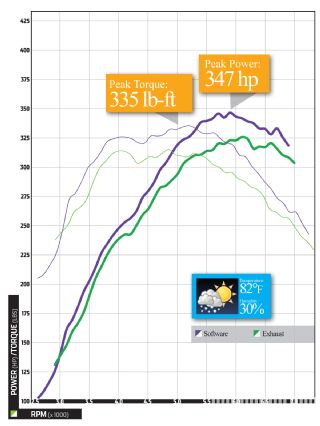 |
Graph 2: VFE RSS-32 vs. exhaust
|
Graph 2: VFE RSS-32 vs. exhaust
Parts: High-flow catalyst assembly, exhaust sealant, clamps, resonated front pipe section, rear silencer w/100mm tips, Milltek stickers Tools: 13mm and 16mm socket, pry bar, ratchet, anti-seize, 22mm box wrench, WD-40 Installation time: 1-1.5 hours MSRP: $2,498
Pros
• Mandrel bent tubing stainless steel piping
• Reduced weight when compared to the stock system
• High quality catalytic converters reduce backpressure and optimize flow while keeping emissions in check to prevent check engine light
• Exhaust can be purchased with or without a resonator on the front pipe to control sound levels
CONS
• Slip-joint construction requires a few attempts to get everything lined up
• Once muffler clamps are tightened, system is difficult to remove or adjust
Test Notes
We had to let the exhaust cool for a while before we swapped it out. By the time we were finished it was time to call it a day, so the exhaust test was performed the following morning.
VF Engineering RSs-32
Race gas vp-109 software and fuel pump
Test 3
Performance
Peak power: 407 hp @ 6700 rpm
Peak torque: 375 lb-ft @ 3800 rpm
Peak gain: 83 hp @ 6900 rpm
Peak gain: 60 lb-ft @ 3500 rpm
Temperature: 69° F
Humidity: 30%
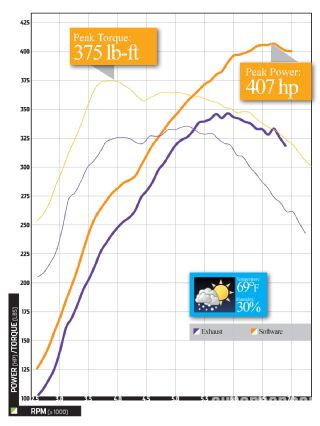 |
Graph 3: software vs. EXhaust System
|
Graph 3: software vs. EXhaust System
Parts: Software, fuel pump
Installation time: 1-1.5 hours
MSRP: $1,400
Pros
• GIAC multi-program option allows easy switching between 91 and 109 octane
• Great way to get extra power for a day at the track or an excursion through the canyons
Cons
• Cost of VP-109
Test Notes
After we ran the Milltek exhaust dyno, a quick glance at the vehicle's fuel gauge told us that there was too much fuel to accurately run the VP-109 fuel test. We could have drained the fuel tank but instead the vehicle was driven until the fuel tank was nearly dry, which took a few days. Once it was dry and the parts and software were installed, we added two gallons of the VP-109 and ran the test. From beginning to end this Proven took about two weeks to complete, not normally the way we like to do tests, but that's just the way it had to be. We should point out that during this test there was a 13 degree drop in outside temperature-a definite advantage for a turbocharged engines and enough to give a more positive result.
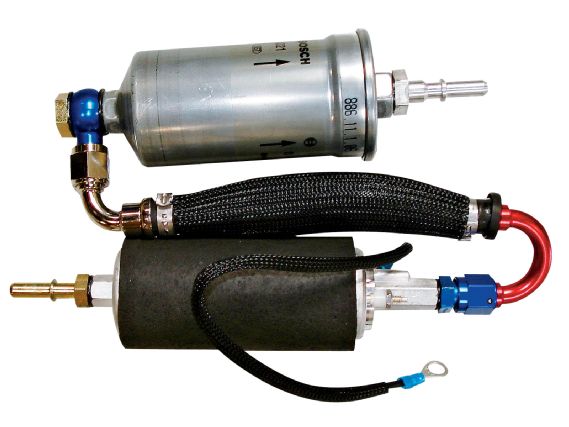 |
Volkswagen MkIV R32 - Proven
|
Volkswagen MkIV R32 - Proven
Conclusion The MKIV R32 test vehicle was in near stock form with just suspension modifications including Bilstein PSS9 coilovers and front and rear swaybars. After I did the baseline runs, I dropped it off at VF engineering for turbo installation. Three days later I came back to do the second round of dynos with just RSS-32 turbocharger system installed. The numbers were impressive and the dyno plots were pretty smooth - always a good sign. After multiple runs to verify the results, it was time to get off the dyno and onto the road.
Over the years I have developed contempt for turbo or supercharger conversions because on average they typically don't work as well as factory setup. While you get gobs of power it comes at a price- you never leave your house without a laundry list of tools, extra oil, jug of water, gloves, and AAA card with 100 mile tow option. You're your behind the wheel of your super or turbocharged monstrosity, you spend most of your time concerned about every noise and not enjoying your new found power. But, as soon as I started the VF RSS-32 equipped R32 I was already impressed when the vehicle fired up on just one turn of the key. My first few miles behind the wheel were in traffic and completely uneventful. During everyday traffic conditions the vehicle behaved - idle was smooth, low speed shifts were not jerky, and there was literally no evidence of the kits existence- it was awesome.
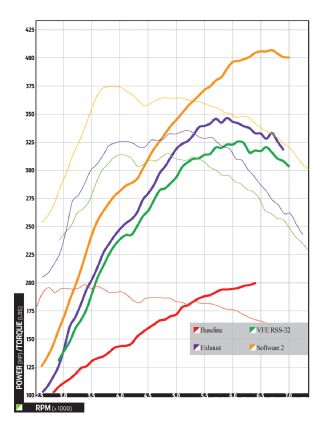 |
Graph 4: Compare all
|
Graph 4: Compare all
After fighting my way through traffic I finally reached a stretch of road that would allow me to see what was reflected on the dyno plot - a good solid power band that pulls all the way to 7K rpm. As soon as I mashed the pedal to the floor there was this little pause before all hell broke loose and propelling the R32 through 1st gear so quickly it left me a little disorientated. After refocusing I hit the canyons. The R32 tore through it like an 800 pound gorilla looking for dinner. What I like most about the R32 was that the extra power did not make the vehicle unbalanced.
The addition of the Milltek exhaust system and Milltek high-flow catalytic convertor assembly created this amazing melody that filled the air. Milltek exhaust gave the R32 a lighter crisper feel throughout every gear and throttle position. Even though the exhaust wasn't designed for use on a turbocharged car, it did a decent job of reducing back pressure.
I could have stopped there and been completely happy but when someone offers you 80 extra horsepower and 60 extra torque, and all you need to do is install a few parts and software it's too tempting to pass up. Plus when it comes time to use it, all you have to do is run VP-109 fuel and push a button. So we brought the vehicle back a week later to have it done, and let's just say only expletives can be used to describe the feeling that an additional 80 horsepower and we'll leave it at that.
In 2004 if Volkswagen released the MKIV R32 with 326 wheel horsepower the reviews of the R32 and my garage space would have looked completely different. The VF-Engineering's RSS-32 Stage 1 turbocharger system completely transformed the R32 without throwing it out of whack - creating a vehicle that has the balance of power and drivability with daily reliability.
PARTS COST VFE RSS-32 STAGE 1 $7,950 MILLTEK EXHAUST $1,099 MILLTEK CATALYTIC CONVERTOR $1,399 VFE RSS-32 RACE GAS $1,400 MSRP TOTAL. $11,848
